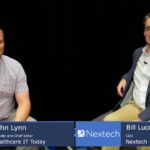We’re excited to share the topic and questions for this week’s #HITsm chat happening Friday, 3/29 at Noon ET (9 AM PT). This week’s chat will be hosted by Sarah Bennight (@SarahBennight) on the topic of “New Healthcare Communication Paradigms”.
 Human communication has encountered multiple paradigm shifts from the development of standardized language, to letter writing, the first phone call, and more recently, email, instant messaging, and social media. While multiple channels are available to connect, Americans are quickly coming to prefer digital communications over voice calls. In 2011, 31% of Americans surveyed reported a preference to text over a voice call. By 2015, this number had grown to 71% (according to Pew Research). Add in all the social media platforms, blogs, and video platform as a way of communicating, and we have a large network of digital ways to connect. It’s easy, convenient, and entertaining.
Human communication has encountered multiple paradigm shifts from the development of standardized language, to letter writing, the first phone call, and more recently, email, instant messaging, and social media. While multiple channels are available to connect, Americans are quickly coming to prefer digital communications over voice calls. In 2011, 31% of Americans surveyed reported a preference to text over a voice call. By 2015, this number had grown to 71% (according to Pew Research). Add in all the social media platforms, blogs, and video platform as a way of communicating, and we have a large network of digital ways to connect. It’s easy, convenient, and entertaining.
While the digital age is revolutionizing the way we connect, we can’t dismiss the downside of having predominantly digital communication. Verbal communication and the actual words we use equate to only 35% of the holistic conversation. Thus, nonverbal communication is a large part of communication as a whole, and with the paradigm shift to digital, it often gets lost in translation. You can easily hide distress or unhappiness over text messages and digital media, making for less transparent conversations. And the blatant lack of nonverbal signals can completely change the course and outcome of a conversation. Furthermore, when researching how non-verbal communication affects our emotional well-being, studies on Gen Z have shown that while they are physically safer than their Gen X or Millennial counterparts, they are the most anxious generation, largely due to their constant digital presence and text/social media relationships.
Within healthcare, the rise of digital communications is no surprise. While healthcare has traditionally lagged behind commercial industries, many patients today have online scheduling, email and text appointment reminders, bill text reminders and even virtual health assistants shaping their patient experience. Many consumers of health have already interacted with some type of virtual health assistant, many times without even realizing it. Healthcare Dive recently gave a list of the top healthcare virtual assistants. The value they bring to the patient education and navigation of clinical information is undeniable. According to Global Market Insights, the virtual health assistant market is expected to exceed $1.5 billion by 2024.
Beyond the virtual assistant, early adopters of chatbots in healthcare have already been shown to improve the experience a patient has before even entering the organization. For example, last year at Healthcare Marketing and Physician Strategies Summit, Matt Gove, Chief Consumer Officer for Piedmont Healthcare showed attendees how he changed the website experience for the health system by adding chatbot functionality. He saw that 70 percent of website visitors would leave the site within 10 seconds and wanted a better way for patients to navigate their questions online. Replacing the visitor section with a data driven chatbot, they were able to improve the experience and quickly serve up answers to their visitors. But this doesn’t come without a human element. If the chatbot doesn’t know the answer to a question, they are redirected to a human to continue the chat session. And they have seen such great success, like a 20% increase in conversions, that the desire is to expand the functionality over time.
“We’re not at the point where we can replace a whole website with a chatbot,” says Gove, “but that’s where we’re headed.”
As chatbots and virtual assistants become the norm, and clinical and informational healthcare communications trend towards digital interactions, what are the things we should be concerned with as a healthcare industry? With the non-verbal cues so valuable to basic communication understanding, how we can make our interactions more efficient but keep the patient at the front of our care models and formation. Join this chat to discuss the new healthcare communication paradigms and how it will shape the patient experience.
Topics for this week’s #HITsm Chat:
T1: What method of communication do you prefer, and how has it shaped/changed/enhanced your relationships? Does it affect how you choose a doctor or healthcare org? #HITsm
T2: What virtual assistants do you use on a daily or weekly basis? How do they improve your quality of life? #HITsm
T3: How have chatbots helped or hurt the commercial consumer experience? What are some examples of companies doing it well? #HITsm
T4: What can healthcare customer/patient experience professionals learn from commercial organizations effectively using AI and automated customer service? #HITsm
T5: In the future, how far can we take the AI and virtual assistant without needing human interaction? What other areas can you see this as helpful? #HITsm
Bonus: Will the continued digitization of communications hurt our emotional wellbeing and relationships? How can we prevent it? #HITsm
Upcoming #HITsm Chat Schedule
4/5 – The Tension Between Privacy and Social Interaction for Online Peer Support Groups
Hosted by David Harlow (@healthblawg)
4/12 – TBD
Hosted by TBD
We look forward to learning from the #HITsm community! As always, let us know if you’d like to host a future #HITsm chat or if you know someone you think we should invite to host.
If you’re searching for the latest #HITsm chat, you can always find the latest #HITsm chat and schedule of chats here.













